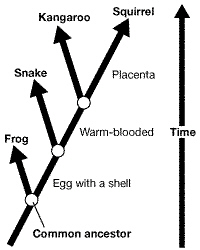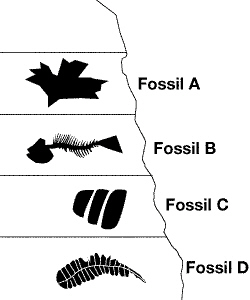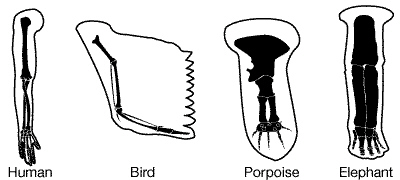Multiple Choice
Identify the
choice that best completes the statement or answers the question.
|
|
|
1.
|
A method of estimating the age of a rock sample in years is called:
a. | decaying. | b. | absolute dating. | c. | relative
dating. | d. | uranium dating. |
|
|
|
2.
|
Certain lizards have coloring that allows them to blend into the background of
their environment to hide from predators. This is an example of a(n):
a. | homologous structure. | b. | adaptation. | c. | behavioral
characteristic. | d. | evolutionary mechanism. |
|
|
|
3.
|
The climate of a certain area is cold, and snow is found on the ground most of
the year. Equal numbers of two populations of rabbits are introduced into this climate by a group of
scientists. One of the populations is brown and the other is white. Predict what will happen over
several generations.
a. | There will be more white rabbits than brown rabbits. | b. | There will be more
brown rabbits that white rabbits. | c. | There is no way to predict what will happen to
the rabbit population. | d. | There will be equal numbers of brown and white
rabbits. |
|
|
|
 Figure 14-1A Figure 14-1A
|
|
|
4.
|
In Figure 14-1A, the rock labeled B is:
a. | older rock. | b. | Not able to be dated | c. | new
rock. | d. | the same age. |
|
|
|
5.
|
Rock pieces sometimes found inside another rock as shown in Figure 14-1A are
called:
a. | sediments | b. | faunal successions | c. | cross
cutting | d. | inclusions |
|
|
|
6.
|
Variations in a population are caused by:
a. | artificial selection. | b. | selective breeding. | c. | natural
selection. | d. | random mutations. |
|
|
|
7.
|
When a population becomes divided by an event such as a new river forming, ____
has occurred.
a. | separation | b. | differentiation | c. | adaptation | d. | isolation |
|
|
|
8.
|
The process of how organisms acquire adaptations over time is called:
a. | evolution. | b. | adaptation. | c. | selective
breeding. | d. | natural selection. |
|
|
|
9.
|
Absolute dating studies the radioactive decay of:
a. | carbon. | b. | lead atoms. | c. | uranium and
carbon. | d. | oxygen and uranium. |
|
|
|
10.
|
Another name for selective breeding is:
a. | homologous selection. | b. | artificial selection. | c. | natural
selection. | d. | genetic engineering. |
|
|
|
11.
|
In the cladogram below, which two species have the weakest evolutionary
relationship?  a. | Squirrel and Kangaroo | c. | Squirrel and Snake | b. | Squirrel and Frog | d. | Kangaroo and
Snake |
|
|
|
 Figure 14-2A Figure 14-2A
|
|
|
12.
|
In Figure 14-2A, fossils found in layer B are:
a. | older than fossils in layer D, but younger than fossils in layer
A. | b. | older than fossils found in layer A, but younger than fossils in layers C and
D. | c. | the oldest. | d. | probably of organisms that are still living
today. |
|
|
|
13.
|
In Figure 14-2A, if the fossil of a human ancestor was found in layer A, then
layer D would most likely contain:
a. | dinosaur fossils. | b. | other human ancestor
fossils. | c. | trilobite fossils. | d. | modern human
fossils. |
|
|
|
14.
|
The principle stating that layers of sedimentary rocks that are the
“lowest” are the earliest to be deposited is:
a. | absolute dating. | b. | rock formation. | c. | horizontal
layering. | d. | superposition. |
|
|
|
15.
|
If an environment changes, populations with ____ have a better chance of
survival.
a. | a large number | b. | a small number | c. | no genetic
variations | d. | genetic variations |
|
|
|
16.
|
Extinction occurs when ____ happens.
a. | loss of habitat | b. | isolation | c. | differentiation | d. | adaptation |
|
|
|
17.
|
A scientist who studies fossils is called a:
a. | geologist. | b. | paleontologist. | c. | biologist. | d. | stenologist. |
|
|
|
18.
|
Which fossil is the oldest in the drawing below?  a. | Fossil A | c. | Fossil C | b. | Fossil B | d. | Fossil D |
|
|
|
19.
|
Which statement is true of natural selection?
a. | It is the same process as artificial selection. | b. | Animal and plant
breeders select desired traits to produce changes in a species. | c. | It is the mechanism
of evolution. | d. | It is a much shorter process than artificial
selection. |
|
|
|
20.
|
As a populations’ habitat changes over time, which species would have a
better chance of survival?
a. | A species with a high level of variation | b. | A species with a low
level of variation | c. | A species that rarely
mutates | d. | A species that feeds only on one type of food |
|
|
|
21.
|
 The picture shows the
same piece of anatomy for 4 different species. The structures shown are referred to as: a. | analogous structures. | c. | arms. | b. | vertebrates. | d. | homologous
structures. |
|
|
|
22.
|
Scientists have collected many fossils of horse ancestors. The use of fossils to
trace the evolution of the horse is known as:
a. | DNA analysis. | b. | comparing embryos. | c. | comparative
anatomy. | d. | the fossil record. |
|
|
|
23.
|
What happens when species produce too many offspring?
a. | Only those that are best fit can survive. | b. | Only those that are
least fit can survive. | c. | Species eat less so that all can
survive. | d. | Species share the limited resources. |
|
|
|
24.
|
Which of the following must happen for a new species to evolve?
a. | Isolation | b. | Adaptation | c. | Differentiation | d. | All of the
above |
|
|
|
25.
|
Evidence for evolution can be found in:
a. | the fossil record. | b. | comparative anatomy. | c. | DNA
analysis. | d. | All of the above |
|